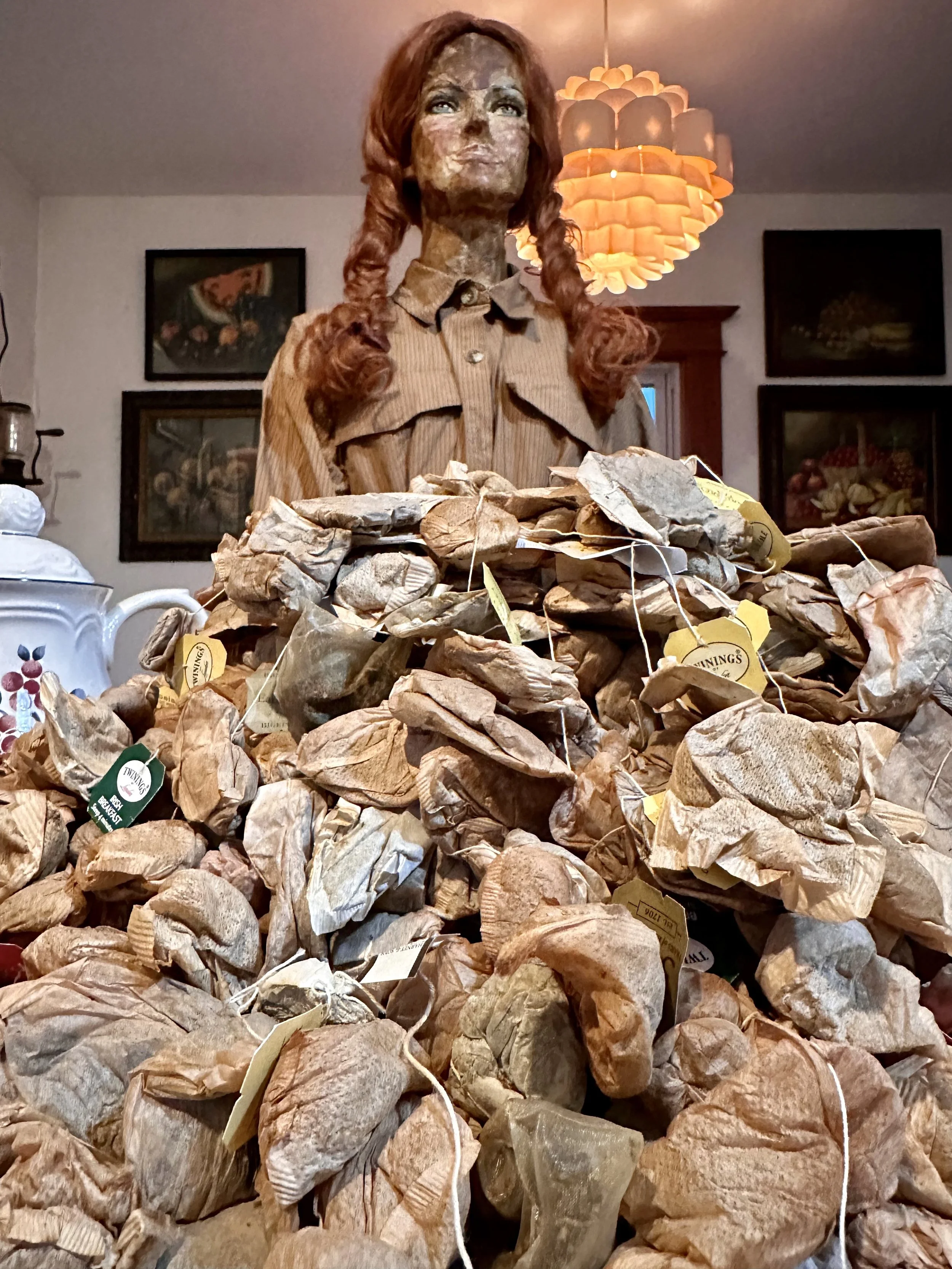Material Meaning- The Story Behind the Tea Bags
Which came first, the mannequin or the tea bags?
Linda, the Mannequin
Linda came into our lives as a Christmas gift for my daughter, who, around age 9 or 10, asked for a mannequin. She arrived in a life sized box, labeled with her name: Linda.
Linda didn’t last long in the bedroom— she creeped my daughter out at night. Eventually, she was banished to a closet, disassembled and stored away.
Years later, after I moved from city to countryside, Linda reemerged — this time as a garden scarecrow. People driving by would stop and ask, “Who’s that woman in your garden?”
After being weather-beaten by sun, wind and rain, Linda retired from scarecrow duty. She began floating around our home, indoors and out. She was photographed cooking, hanging laundry on a clothes line, getting into the driver seat of an old junker, interacting with puppies, welding and more.
Linda had evolved into something more — a muse.
She was never intended to be art. It happened the way things do, in their own time, and as they should.
Why Tea Bags?
There was a time in my life when tea became a kind of placebo. I drank it to self-soothe. I wasn't one to "hit the hard stuff" and I’m not a pill popper- so tea became my quiet addiction. Cup after cup, every day. Black in the morning, green or herbal after lunch and into the evening. The kettle at home, the electric model at work. It was one small, steady ritual in my practice of enduring profound grief.
At the same time, my grandmother was dying. I loved her dearly.
When she was still well enough to write, she mailed me something: a magazine clipping showing dried tea bags stitched into a delicate, quilt-like pattern. It struck me instantly: the colors, the textures, the organic beauty of it. Granny was a quilter; the design spoke to her sensibilities. She knew how to make use of what she had-not just make do but make things functionally appealing.
I called to tell her how much I loved the clipping-the cleverness of it, the unexpected elegance.
Ironically, Granny herself was a lifelong coffee drinker. Black with sugar, sometimes a splash of milk. All day long. She was probably perpetually dehydrated.
When I was in grade school, we’d sit at the kitchen table playing gin rummy. She’d sip her strong black coffee, and she’d make me a kid version — half milk, tons of sugar. It tasted like a liquid candy bar. I loved it. She usually won at cards.
Granny was frugal by necessity. Her mother died too soon, leaving her to raise a younger brother and care for her father. Money was tight — tighter than tight. Nothing was thrown away that might serve a purpose. That mindset stayed with her. And, in many ways, it lives on in me.
I pinned that clipping to our bulletin board and stared at it for months. One day, without planning to, I saved a used tea bag. Then another. And another. And I’ve been saving them ever since.
The First Tea Bag Project
The first time I used tea bags in my work, I glued them to a canvas board, intending to paint something as a gift for my grandmother. She died before I began, I never touched the canvas again.
She never knew of my grief— I kept it from her, lied so wouldn’t worry.
That canvas stayed with me. So did the tea bags, accumulating rapidly.
The Transformation
Years later, with Linda retired from her post in the garden and drifting through her “in-between jobs” phase, I came across Granny’s clipping and the tea-bag-covered canvas. Something clicked.
I looked at Linda- worn, wounded, missing a hand, her arm nailed into a stiff position — and I thought of the thousands of cups of tea I’d consumed over those hard years. Thousands of moments measured in degrees of pain. I thought of human flesh. Of fragility. Of durability too.
I started with her face. One tea bag, then another. They transformed her.
People who saw her were stunned. “She looks more human than ever,” they said. The translucency of the tea bags didn’t conceal what was beneath- they revealed it. They enhanced her form with subtle light, shadow, and a quiet emotional gravity. The effect was haunting. She was stunning.
She reminded me of the Body Worlds exhibit— exposed muscle, raw vulnerability, a study in resilience. Linda had become more than a mannequin. She became a monument. A sculptural archive. A reflection of endurance and strength.
Linda is not me. But she carries my story.
I still drink tea almost every day- just a cup or two cups for pleasure. And I still save every tea bag.
